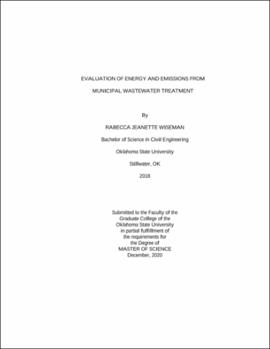| dc.contributor.advisor | Krzmarzick, Mark | |
| dc.contributor.author | Wiseman, Rabecca Jeanette | |
| dc.date.accessioned | 2021-05-25T21:00:25Z | |
| dc.date.available | 2021-05-25T21:00:25Z | |
| dc.date.issued | 2020-12 | |
| dc.identifier.uri | https://hdl.handle.net/11244/330005 | |
| dc.description.abstract | Wastewater treatment is a core societal commodity responsible for maintaining the health of humans and downstream ecosystems. Because the purpose of wastewater treatment plants (WWTPs) is to remove pathogens and organic matter from the water, other objectives such as energy efficiency and material recycling can easily fall to the way-side. To improve the overall efficiency of these treatment facilities, energy expenditure analysis is needed to better understand how to make electric consumption reduction efforts most effective. The analysis of WWTP energy and emissions for facilities in Oklahoma required the procurement of process data such as flow rates, energy and resource consumption, and unit processes present. The WWTPs chosen for analysis had to fit within two different ranges. First, OK WWTPs were separated by the population size they were serving. Those serving a small population (less than 100,000) were chosen because literature suggests these WWTPs exhibit higher than average electric consumption on a per volume basis. Secondly, facilities need to be treating the wastewater of a large enough population (more than 10,000) for the potential energy use to be significant enough to financially warrant investment in energy saving technology. The population range of the surveyed WWTP's respective municipalities is 10,000 to 100,000 people. Once determining the most energy-intensive unit process of wastewater treatment is activated sludge, analysis in municipal and laboratory applications is necessary to provide insight into possible sustainability improvements. Within a laboratory environment, an activated sludge biological treatment tank is simulated to characterize key water quality parameters throughout the treatment process. Once an effective strategy for accurately simulating a full-scale municipal activated sludge treatment is determined and proven, energy input optimization can occur. This is done as the first step necessary to begin correlating key water parameters to the needed volume of air being pumped into the wastewater. | |
| dc.format | application/pdf | |
| dc.language | en_US | |
| dc.rights | Copyright is held by the author who has granted the Oklahoma State University Library the non-exclusive right to share this material in its institutional repository. Contact Digital Library Services at lib-dls@okstate.edu or 405-744-9161 for the permission policy on the use, reproduction or distribution of this material. | |
| dc.title | Evaluation of energy and emissions from municipal wastewater treatment | |
| dc.contributor.committeeMember | Lampert, David | |
| dc.contributor.committeeMember | Wilber, Gregory | |
| osu.filename | Wiseman_okstate_0664M_17034.pdf | |
| osu.accesstype | Open Access | |
| dc.type.genre | Thesis | |
| dc.type.material | Text | |
| dc.subject.keywords | aeration | |
| dc.subject.keywords | treatment | |
| dc.subject.keywords | wastewater | |
| thesis.degree.discipline | Environmental Engineering | |
| thesis.degree.grantor | Oklahoma State University | |
